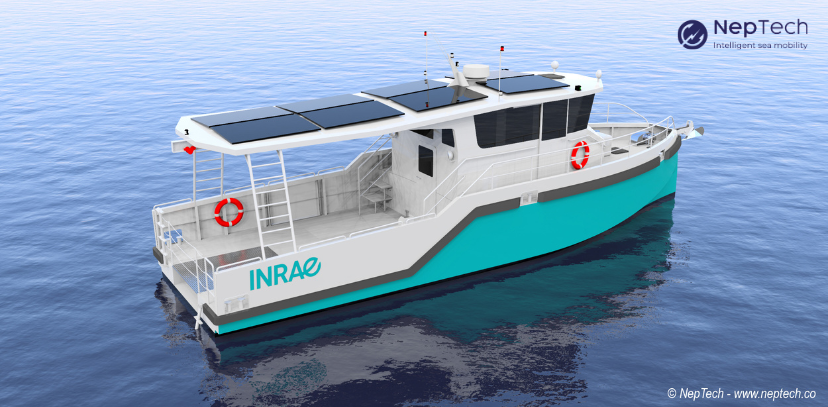
How to choose the propulsion system for river and sea Shuttles? Electric boat? Electro-hydrogen? Hybrid diesel-electric? Biofuel? Each option has its own characteristics and advantages. This article explores the main low-carbon propulsion solutions and the recommended decision criteria to guide this choice.
Each year, 940 million tons of CO2 are emitted by maritime transport, accounting for 13% of transport-related greenhouse gas (GHG) emissions in Europe. Maritime and river traffic is increasing, as are its emissions, at a time when drastic environmental protection measures are emerging. In this context, ship operators face a major challenge: how to reduce their carbon footprint while maintaining optimal performance?
The choice of propulsion becomes a strategic issue, influenced by various factors such as the duration and distance of journeys, the availability of charging or refueling infrastructure, and economic constraints. Faced with increasingly strict regulations and growing pressure to adopt cleaner technologies, selecting the right propulsion system is essential to ensuring the sustainable operation of an electric ship.
Low-carbon propulsion solutions
NepTech recommends several propulsion solutions for river and sea shuttles ranging from 10 to 30 meters, intended for regular routes or short tourist trips. While this list is not exhaustive, it provides an overview of the most common options.
100% electric propulsion
100% electric propulsion, using battery-powered electric motors, is ideal for short trips at low speeds and is particularly suited for small vessels (<20m).

Escale Sétoise, electric boat operating in Sète, South of France
To date, LFP (lithium iron phosphate) batteries are the safest and most widely used solution. Several suppliers offer certified solutions for the maritime and river transport sectors. However, researchers and project developers are testing new technologies to further enhance this option.
Electro-hydrogen propulsion
Electro-hydrogen propulsion, which uses electric motors powered by a hydrogen fuel cell and battery storage, is recommended for journeys requiring long autonomy or demanding operational profiles, while minimizing energy consumption.
Fuel cells convert hydrogen into electricity, drastically reducing CO2 emissions, provided “green” hydrogen produced from renewable energy sources is used. However, despite its promise, this technology remains underdeveloped due to the lack of hydrogen supply infrastructure.

Electro-hydrogen vessel project in Paris
Diesel-electric hybrid propulsion
Diesel-electric hybrid propulsion combines electric motors powered by a diesel generator. This option is ideal for long journeys or demanding operational profiles. If diesel-electric hybrid propulsion is chosen, NepTech recommends using HVO biofuels to minimize greenhouse gas emissions.
What about solar panels?
Adding solar panels can be highly beneficial, providing additional energy on board. Solar panels can be installed on both electric and hybrid vessels.
Their use allows for optimal utilization of available space. These panels can help power auxiliary loads on the vessel, offering an extra energy source while contributing to an overall strategy of using renewable and decarbonized energy.

Vessel (outside NepTech range) with hybrid diesel-electric propulsion + solar panels
Selection criteria
Operational profile or usage profile of the vessel
The choice of propulsion system should primarily be guided by the vessel’s usage profile: its route, distance to be covered, speed, number of operating hours, and turnaround time, among other factors. This is a crucial step to ensure the success of a low-carbon project.
100% electric propulsion is suitable for short, low-speed trips. For longer, faster journeys or more demanding and energy-intensive operational profiles, a hybrid solution is preferable.
Investment and operating costs
The initial investment in low-carbon propulsion can be high, but it balances out over the long term through reduced fuel costs and lower CO2 emission-related taxes. The choice of hydrogen, in particular, can be challenging due to the costly infrastructure it requires. Therefore, it’s important to research upcoming hydrogen projects in the local area and available public subsidies to offset these costs.
Availability of infrastructure
The availability of refueling or charging infrastructure is another key factor. For example, hydrogen requires specific refueling stations, while electrification assumes access to charging points.
For electric vessels, recharging can often be done via standard electrical outlets, without requiring complex infrastructure. However, it is crucial to ensure that an electrical connection is available at the quay or port. In some cases, a higher-power charging station may be needed to power the chargers and reduce charging time.
Regulations and environmental standards
Local and international regulations can significantly influence the choice of propulsion system. It is essential to comply with current standards and anticipate regulatory developments, which are increasingly moving towards stricter emission requirements.
Choosing the propulsion system for an electric vessel must balance performance, operational constraints, and infrastructure availability. NepTech supports operators and project developers in greening their fleets and structuring projects for electric boat or low-carbon vessels.

Recent Comments